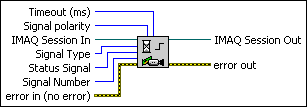IMAQ Wait Signal2 VI
Installed With: NI Vision Acquisition SoftwareWaits for either a status or trigger signal to be asserted. IMAQ Wait Signal2 does not return until the specified signal is asserted or a timeout occurs.

 |
Timeout (ms) specifies the amount of time to wait for the assertion edge of Signal in milliseconds. The VI returns an error is the assertion edge does not occur within the specified time. |
||||||||||||
 |
Signal polarity specifies the polarity of the status or trigger signal parameter. The following values are valid:
|
||||||||||||
 |
IMAQ Session In identifies the device. |
||||||||||||
 |
Signal Type specifies the type of signal that causes the occurrence to be set. The following values are valid:
|
||||||||||||
 |
Status Signal Signal specifies the signal that causes the occurrence to be set if Signal Type is set to Status. The following values are valid:
|
||||||||||||
 |
Signal Number specifies the number of the trigger line that causes the occurrence to be set if Signal Type is set to one of the trigger types. |
||||||||||||
 |
error in (no error) describes error conditions that occur before this VI or function runs. The default is no error. If an error occurred before this VI or function runs, the VI or function passes the error in value to error out. This VI or function runs normally only if no error occurred before this VI or function runs. If an error occurs while this VI or function runs, it runs normally and sets its own error status in error out. Use the Simple Error Handler or General Error Handler VIs to display the description of the error code. Use error in and error out to check errors and to specify execution order by wiring error out from one node to error in of the next node.
|
||||||||||||
 |
IMAQ Session Out has the same value as IMAQ Session In. |
||||||||||||
 |
error out contains error information. If error in indicates that an error occurred before this VI or function ran, error out contains the same error information. Otherwise, it describes the error status that this VI or function produces. Right-click the error out indicator on the front panel and select Explain Error from the shortcut menu for more information about the error.
|






